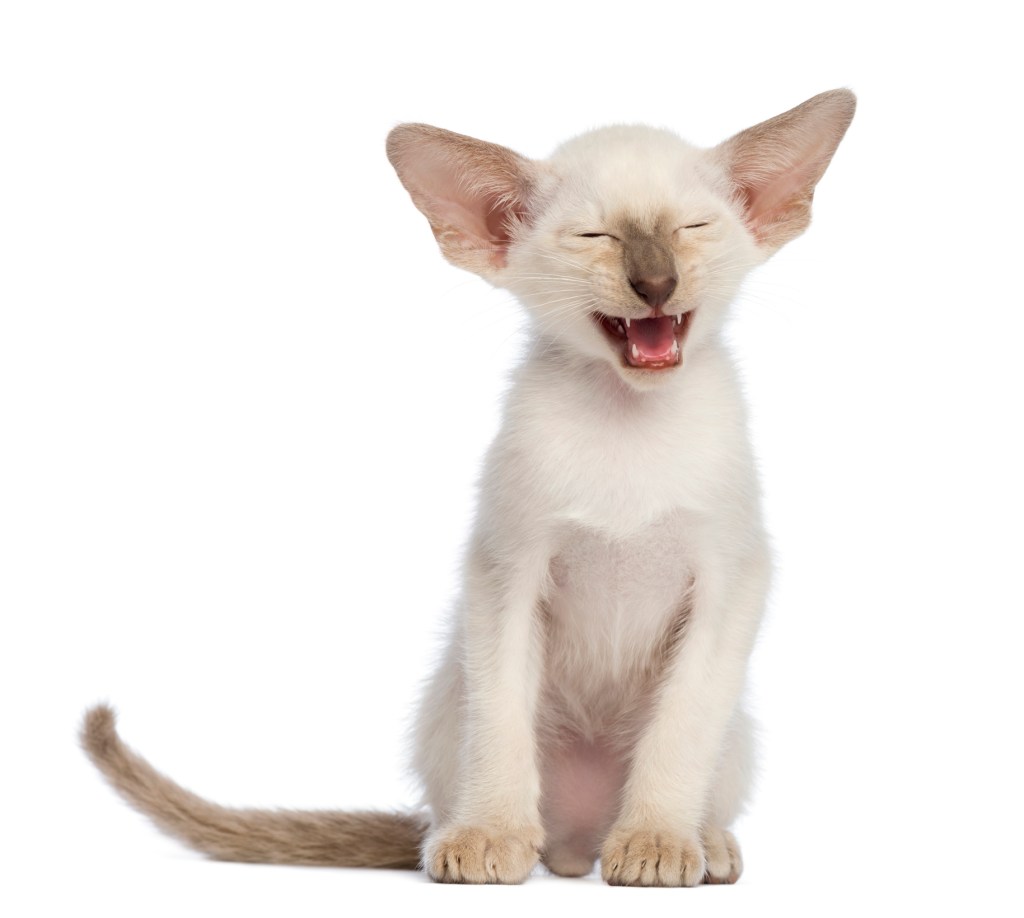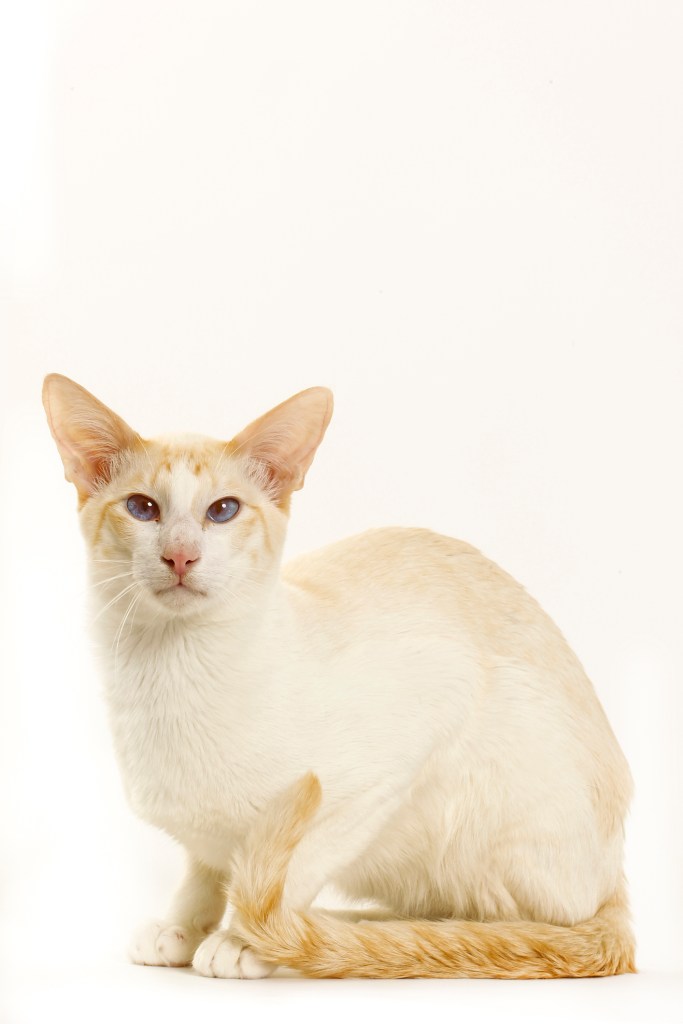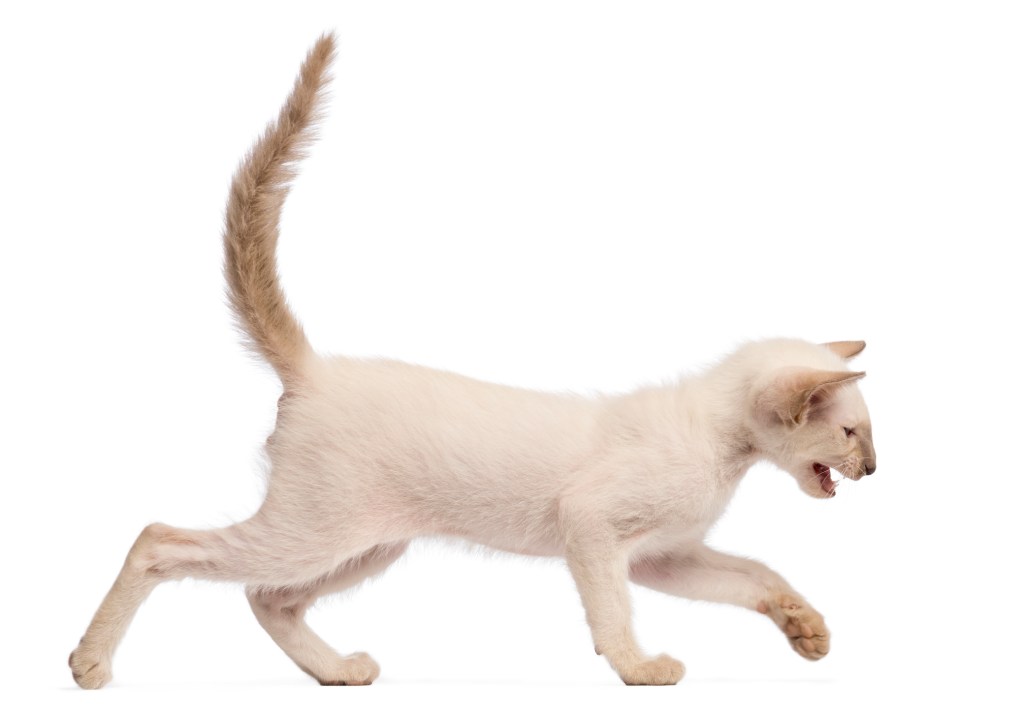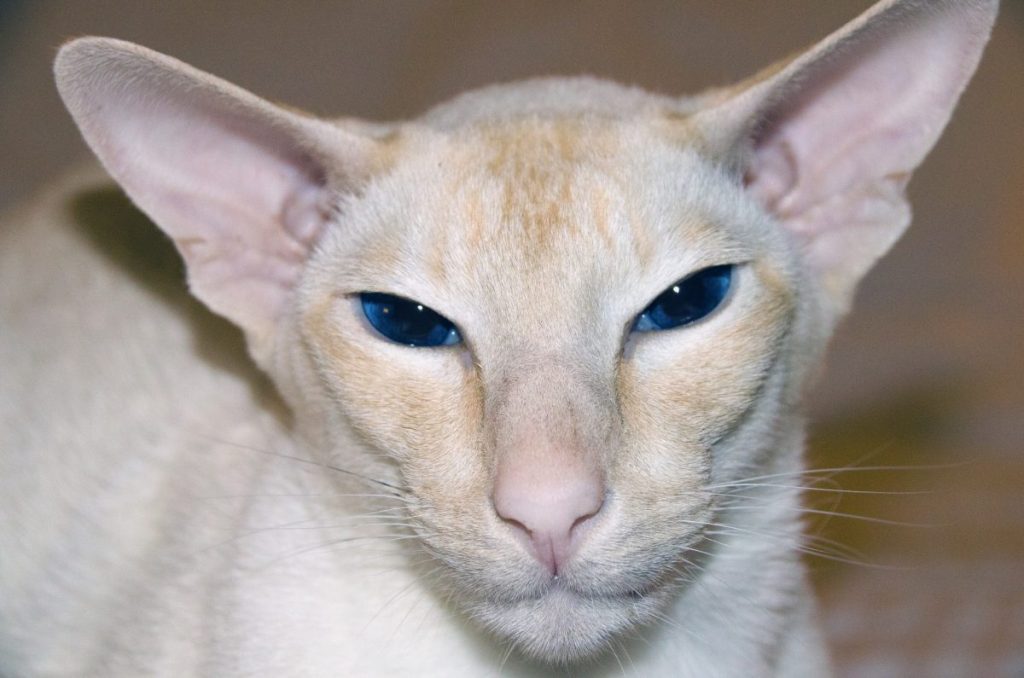The Colorpoint Shorthair cat, an offshoot of the Siamese breed, is distinguished by their striking color patterns and captivating blue almond-shaped eyes. This breed typically has a lighter body color with darker points on the ears, face, paws, and tail, creating a visually appealing contrast. Colorpoint Shorthair cats come in various color variations, including seal, chocolate, blue, and lilac. The breed is known for their vocal and social nature, often forming strong bonds with their owners. Colorpoint Shorthairs are intelligent and enjoy interactive play, making them well-suited for households that provide mental stimulation and affection. With their sleek, short coat and elegant build, Colorpoint Shorthair cats exhibit a graceful and regal appearance.
In terms of health, Colorpoint Shorthair cats are generally robust, but like other breeds, they may be prone to certain genetic conditions. Regular veterinary check-ups and proper care are important to ensure their well-being. The Colorpoint Shorthair cat’s unique coloration and engaging personality contribute to their popularity among cat enthusiasts, and they remain a beloved and cherished breed in households around the world.
When considering a Colorpoint Shorthair kitten, it’s advisable to prioritize adopting from rescue organizations or shelters to provide a loving home to a cat in need. However, if you decide to purchase a Colorpoint Shorthair kitten, it’s crucial to choose a reputable breeder. Conduct thorough research to ensure that the breeder follows ethical practices and prioritizes the well-being of their cats. Reputable Colorpoint Shorthair kitten breeders prioritize the health and temperament of their cats, conduct necessary health screenings, and provide a nurturing environment for the kitties. This active approach ensures that you bring home a healthy and happy kitty while discouraging unethical breeding practices.
Quick Facts
- Origin: England and United States, developed in the 1960s by crossing American Shorthairs with Siamese cats, aiming for the Siamese markings in a short-haired breed.
- Size: Medium (7-12 pounds), with males generally larger than females.
- Breed Group: Shorthaired Domestic
- Lifespan: 12-16 years
- Coat: Short, smooth, and sleek, with stunning “point” markings on face, ears, legs, and tail. Points come in a variety of colors including seal, chocolate, blue, lilac, red, cream, cinnamon, fawn, and more.
- Temperament: Sociable, affectionate, playful, intelligent, curious, enjoys human interaction and playtime.
- Exercise Needs: Moderate – thrives on daily playtime and mental stimulation.
- Training: Highly trainable due to their intelligence and desire to please, can learn tricks and even leash training.
- Grooming: Weekly brushing recommended to prevent matting, especially around the ears and undercoat.
- Health: Generally healthy, but some potential for genetic health conditions like hypertrophic cardiomyopathy (HCM) and progressive retinal atrophy (PRA).
- The Colorpoint Shorthair cat has 16 different coat patterns!
- This breed is friendlier than your average cat and hates to be alone.
- Some associations consider this the same breed as a Siamese cat.
Colorpoint Shorthair Pictures




-
Affectionate with Family
Some cat breeds are typically independent and aloof, even if they’ve been raised by the same person since kittenhood; others bond closely to one person and are indifferent to everyone else; and some shower the whole family with affection. Breed isn’t the only factor that goes into affection levels; cats who were raised inside a home with people around feel more comfortable with humans and bond more easily.

See Cats Less Affectionate with Family -
Amount of Shedding
If you’re going to share your home with a cat, you’ll need to deal with some level of cat hair on your clothes and in your house. However, shedding does vary among the breeds. If you’re a neatnik, you’ll need to either pick a low-shedding breed or relax your standards. This furniture cover can make it easier to clean up cat hair and keep it off your sofa!
-
General Health
Due to poor breeding practices, some breeds are prone to certain genetic health problems. This doesn’t mean that every cat of that breed will develop those diseases; it just means that they’re at an increased risk. If you’re looking only for purebred cats or kittens, it’s a good idea to find out which genetic illnesses are common to the breed you’re interested in.
-
Potential for Playfulness
Some cats are perpetual kittens—full of energy and mischief—while others are more serious and sedate. Although a playful kitten sounds endearing, consider how many games of chase the mouse-toy you want to play each day, and whether you have kids or other animals who can stand in as playmates. A classic wand cat toy like this one is perfect for playful felines!
-
Tendency to Vocalize
Some breeds sound off more often than others with meows, yowls, and chattering. When choosing a breed, think about how the cat vocalizes and how often. If constant “conversation” drives you crazy, consider a kitty less likely to chat.
-
Kid-Friendly
Being tolerant of children, sturdy enough to handle the heavy-handed pets and hugs they can dish out, and having a nonchalant attitude toward running, screaming youngsters are all traits that make a kid-friendly cat. Our ratings are generalizations, and they’re not a guarantee of how any breed or individual cat will behave; cats from any breed can be good with children based on their past experiences and personality.
-
Easy to Groom
Some breeds require very little in the way of grooming; others require regular brushing to stay clean and healthy. Consider whether you have the time and patience for a cat who needs daily brushing. You should definitely pick up this awesome de-shedding tool for cats of any hair length!
-
Intelligence
Some cat breeds are reputed to be smarter than others. But all cats, if deprived the mental stimulation they need, will make their own busy work. Interactive cat toys are a good way to give a cat a brain workout and keep them out of mischief. This scratcher cat toy can keep your smart kitty busy even when you’re not home!
-
Pet Friendly
Friendliness toward other household animals and friendliness toward humans are two completely different things. Some cats are more likely than others to be accepting of other pets in the home.
Colorpoint Shorthair History
The Colorpoint Shorthair is a Siamese of a different color—non-traditional colors, that is. The breed was developed using Siamese as the foundation and then crossing it with a red American Shorthair to bring in a new color.
That was successful and attractive, and the cats became the basis for a new breed: the Colorpoint Shorthair. Eventually, other non-traditional colors were created. The breed was recognized by the Cat Fanciers Association in 1964. The International Cat Association considers the Colorpoint a variety of Siamese, not a separate breed.
Colorpoint Shorthair Size
Colorpoints are medium-size cats that typically weigh 5 to 10 pounds.
Colorpoint Shorthair Personality
The Siamese and the Colorpoint Shorthair might differ in color, but beneath the skin they are identical. The Colorpoint Shorthair is talkative and opinionated. He will tell you exactly what he thinks, in a loud, raspy voice, and he expects you to pay attention and act on his advice.
Colorpoints are extremely fond of their people. They like to be “helpful” and will follow you around and supervise your every move. When you are sitting down, a Colorpoint Shorthair will be in your lap, and at night he will be in bed with you, probably under the covers with his head on the pillow. Do not get a Colorpoint if living with a chatty busybody would drive you insane.
On the other hand, if you enjoy having someone to talk to throughout the day, a Colorpoint can be your best friend. Just be sure you have time to spend with this demanding and social cat. Colorpoints do not like being left alone for long periods, and if you work during the day it can be smart to get two of them so they can keep each other company.
The Colorpoint is highly intelligent, agile and athletic, and loves to play. Keep his busy brain active with puzzle toys and his body exercised with teaser toys that he can chase and a big cat tree he can climb. He is fully capable of opening doors and drawers or rifling through your purse in search of something interesting or shiny to play with. Never leave him without any form of entertainment, or you will likely come home to find that he has reprogrammed your DVR to record only nature shows or at the very least decided that your toilet paper rolls and tissue boxes look better empty.
Choose a Colorpoint if you look forward to spending time with and interacting with your cat. This is a loyal and loving feline who will pout and pine if given little or no attention. In the right home, however, he thrives for years.
Colorpoint Shorthair Health
Both pedigreed cats and mixed-breed cats have varying incidences of health problems that may be genetic in nature. The same problems that may affect the Siamese can also affect the Colorpoint Shorthair, including the following:
- Amyloidosis: This is a disease that occurs when a type of protein called amyloid is deposited in body organs, primarily the liver in Siamese.
- Asthma: Asthma in cats, also known as feline bronchial disease or feline asthma, is a respiratory condition characterized by inflammation and constriction of the airways. It is a common condition in cats and can affect felines of any age or breed
- Congenital Heart Defects: Congenital heart defects in cats refer to abnormalities in the structure or function of the heart that are present at birth. These defects can vary in severity and may affect different parts of the heart. While some congenital heart defects may not cause significant health problems, others can lead to serious complications.
- Crossed Eyes: Crossed eyes in cats, also known as strabismus, is a condition where a cat’s eyes are misaligned and do not focus on the same point simultaneously. This can be a result of various factors and may affect one or both eyes.
- Megaesophagus: Megaesophagus in cats is a condition characterized by the abnormal enlargement of the esophagus, the muscular tube that transports food from the mouth to the stomach. This enlargement results in a loss of normal esophageal function, leading to difficulties in swallowing and regurgitation.
- Hyperesthesia Syndrome: This is a neurological problem that can cause cats to excessively groom themselves, leading to hair loss, and to act frantically, especially when they are touched or petted.
- Lymphoma: Lymphoma in cats is a type of cancer that originates in the lymphocytes, a type of white blood cell involved in the immune system.
- Nystagmus: A neurological disorder that causes involuntary rapid eye movement.
- Progressive Retinal Atrophy: Progressive Retinal Atrophy (PRA) in cats is a hereditary condition that affects the eyes, leading to a gradual degeneration of the retina. This can eventually result in blindness.
Colorpoint Shorthair Care
The short, fine coat of the Colorpoint is easily cared for. Comb it every couple of weeks with a stainless steel comb or soft bristle brush to remove dead hair, then polish it with a soft cloth to make it shine. Brush the teeth to prevent periodontal disease. Daily dental hygiene is best, but weekly brushing is better than nothing.
Wipe the corners of the eyes with a soft, damp cloth to remove any discharge. Use a separate area of the cloth for each eye so you don’t run the risk of spreading any infection. Check the ears weekly. If they look dirty, wipe them out with a cotton ball or soft damp cloth moistened with a 50-50 mixture of cider vinegar and warm water. Avoid using cotton swabs, which can damage the interior of the ear.
Keep the Colorpoint’s litter box spotlessly clean. Cats are very particular about bathroom hygiene. It’s a good idea to keep a Colorpoint as an indoor-only cat to protect him from diseases spread by other cats, attacks by dogs or coyotes, and the other dangers that face cats who go outdoors, such as being hit by a car. Colorpoints who go outdoors also run the risk of being stolen by someone who would like to have such a beautiful cat without paying for it.
Colorpoint Shorthair Coat Color And Grooming
Except for color, the Siamese and the Colorpoint are indistinguishable, having a svelte but muscular body with long lines and a wedge-shaped head that is long and tapering from the narrow point of the nose outward to the tips of the ears, forming a triangle. The unusually large ears are wide at the base and pointed at the tip, giving them the same triangular shape as the head. Medium-size eyes are almond-shaped.
The body is often described as tubular and is supported by long, slim legs, with the hind legs higher than the front legs. The Colorpoint walks on small, dainty, oval paws and swishes a long, thin tail that tapers to a fine point. Colorpoints come in 16 colors and patterns, including red point, cream point and lynx point. The coat often darkens as the cat ages. Eyes are a vivid blue.
Children And Other Pets
The active and social Colorpoint is a perfect choice for families with children and cat-friendly dogs. He will play fetch as well as any retriever, learns tricks easily and loves the attention he receives from children who treat him politely and with respect. He gets along with cats and dogs who respect his authority. Always introduce pets slowly and in controlled circumstances to ensure that they learn to get along together.
Colorpoint Shorthair Rescue Groups
More Info For You
If you’re also looking for a dog, check out DogTime’s dog breed page!





